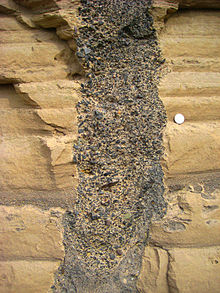The examples and perspective in this article deal primarily with the United States and do not represent a worldwide view of the subject. (April 2016) |

A clastic dike is a seam of sedimentary material that fills an open fracture in and cuts across sedimentary rock strata or layering in other rock types.
Clastic dikes form rapidly by fluidized injection (mobilization of pressurized pore fluids) or passively by water, wind, and gravity (sediment swept into open cracks). Diagenesis may play a role in the formation of some dikes.[1] Clastic dikes are commonly vertical or near-vertical. Centimeter-scale widths are common, but thicknesses range from millimetres to metres. Length is usually many times width.
Clastic dikes are found in sedimentary basin deposits worldwide. Formal geologic reports of clastic dikes began to emerge in the early 19th century.[2][3][4][5][6][7]
Terms synonymous with clastic dike include: clastic intrusion, sandstone dike, fissure fill, soft-sediment deformation, fluid escape structure, seismite, injectite, liquefaction feature, neptunian dike (passive fissure fills), paleoseismic indicator, pseudo ice wedge cast, sedimentary insertion, sheeted clastic dike, synsedimentary filling, tension fracture, hydraulic injection dike, and tempestite.
- ^ Davies, Richard J.; Huuse, Mads; Hirst, Philip; Cartwright, Joe; Yang, Yuesuo (2006). "Giant clastic intrusions primed by silica diagenesis". Geology. 34 (11): 917. Bibcode:2006Geo....34..917D. doi:10.1130/G22937A.1.
- ^ Darwin, C., 1833–1834, Geological observations on the volcanic islands and parts of South America visited during the voyage of the H.M.S. “Beagle” (2nd Edition), p. 438
- ^ Hay, R., 1892, Sandstone dikes in northwestern Nebraska, GSA Bulletin, 3, pp. 50–55
- ^ Case, E.C.; 1895, On the mud and sand dikes of the White River Miocene, Ithaca, N.Y., American Geologist, 24, pp. 248–254
- ^ Crosby, W.O., 1897, Sandstone dikes accompanying the great fault of Ute Pass, Colorado, Essex Institute Bulletin, 27, pp. 113–147
- ^ Diller, J.S., 1890, Sandstone dikes, GSA Bulletin, 1, pp. 411–442
- ^ Several c. 1850 references to dikes in Newsom, J.F., 1903, Clastic dikes, Bulletin of the Geological Society of America, 14, pp. 227–268
